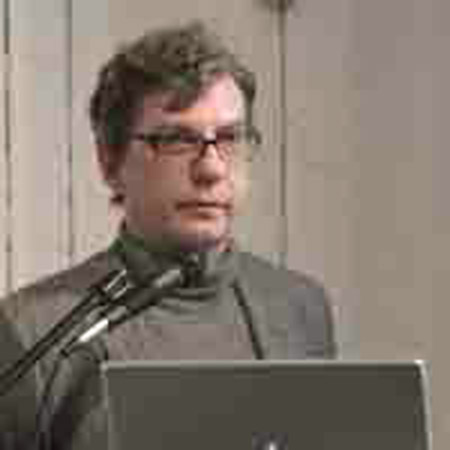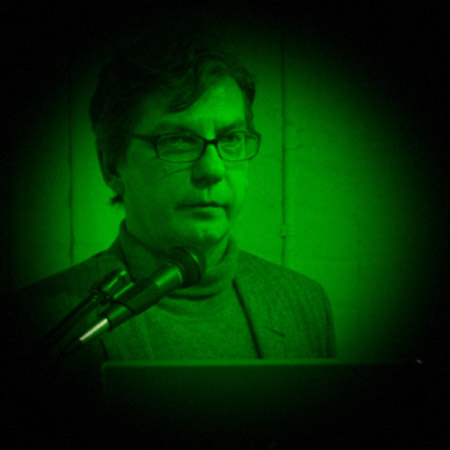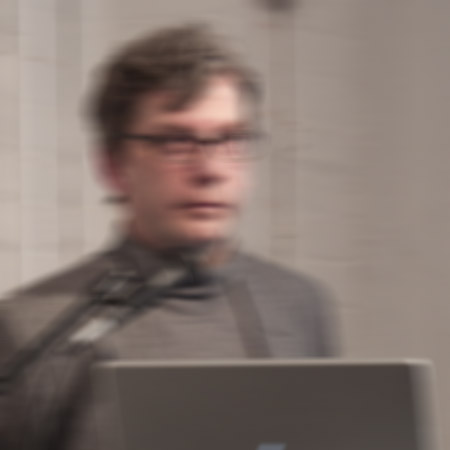Ein Abend mit Thomas Ruff

This past Friday, I went to New York to attend what had been advertized as An Exclusive Conversation Between Thomas Ruff and Philip Gefter. Given that Ruff spent over an hour presenting the history of his work, it was more like an artist’s talk, but it was tremendously interesting nevertheless. The following highlights are culled from my rather illegible notes, and they might shed a bit more light on an artist whose work is not very well understood on this side of the Atlantic.
The first surprise for many might be to learn that Ruff mentioned American colour photographers such as Stephen Shore as being amongst his first major influences - aside from the usual German suspects (Sander, …) - that was when he still believed “that photography could capture reality.”
Ruff spent considerable time talking about the portraits that made him famous. He said he started to have those photos printed very large when - I’m paraphrasing here - viewers did not realize they were looking at a photo of a person (saying “That’s Pia” instead of “That’s a photo of Pia”). That might sound like a minor difference, but it is here where one can actually find the essence of most - if not all - of Ruff’s work: For the artist, the medium always is part of the discourse, and he always wants people to recognize the medium as much as what it conveys (in the words of Bernd Becher, quoted by Ruff: “always reflect the medium”)
Ruff first retouched a photo in 1987, which turned out to be a major production. A photo of an apartment building contained a tree and a car in front - both of which the artist had removed. At an art opening that made a viewer say “this photo is a lie”, but for Ruff, this never was an issue. He would retouch “as much as necessary, as little as possible”, and in the Q&A he gave the simple reason why the tree and car had to go: He wanted to “simplify the image.” I thought that was such a simple and great way to justify the retouching, even though I’m sure it won’t convince the critics, those clinging to the belief that photography ought to show that which is “real”.
 Ruff has worked a lot with images that are not his own, be it the stars, the newspaper clippings, or the images of machines he found on a set of glass plates he bought. Each of those series centers on investigating the essence of authorship or reality in photography: The stars he picked as the most objective photographs one could possibly produce (as an astronomer I’m not sure I agree with this), the newspaper clippings deal with how images are used and transformed when treated in the context of a newspaper, etc. I think it’s important to keep this in mind, given the retouching of the apartment building. Here’s a photographer who not just decided to play with images to have them fit his artistic vision - instead, it’s a photographer who has looked at what photographs can do from a very large number of angles; one could imagine that someone might write a book about what photography is and can do using just Ruff’s various bodies of work.
Ruff has worked a lot with images that are not his own, be it the stars, the newspaper clippings, or the images of machines he found on a set of glass plates he bought. Each of those series centers on investigating the essence of authorship or reality in photography: The stars he picked as the most objective photographs one could possibly produce (as an astronomer I’m not sure I agree with this), the newspaper clippings deal with how images are used and transformed when treated in the context of a newspaper, etc. I think it’s important to keep this in mind, given the retouching of the apartment building. Here’s a photographer who not just decided to play with images to have them fit his artistic vision - instead, it’s a photographer who has looked at what photographs can do from a very large number of angles; one could imagine that someone might write a book about what photography is and can do using just Ruff’s various bodies of work.
I admit I was curious about how Ruff would talk about his nudes, a body of work I personally don’t find particularly interesting. Ruff said he became interested in nude photography, and he wanted to do something that was not the standard “boring 19th Century male heterosexual” stuff (he singled out Helmut Newton, whose work he seems to dislike just as much as I do). And he ended up with teaser images from internet pornography sites, because those were “more honest” than regular nude art photography. So his nudes contain actually a large spectrum of sexual practices (and not just photos of naked girls). I’m not sure I like Ruff’s nudes more knowing this, but I certainly respect the work much more now. And the idea that internet porn is “more honest” than the “boring 19th Century male heterosexual” photography done by Newton and many others I’m sure will make some people a bit uncomfortable.
Ruff’s latest bodies of work all seem to move away from “pure” photography, towards the “structure of photography” that has always been part of his work. Things have become conceptual, and while I don’t think the concepts are always particularly deep, they certainly are very interesting. The jpegs Ruff started to work on when he came back from New York City after 9/11. He actually was in New York that day, and he did take photos, but his roll of film ended up being blank. So he looked for photographs on the internet, and he noted how the internet preferred compressed images that contained artificial structures.
 There was a bit of a Q&A after Ruff’s long presentation, with quite a few interesting moments - a funny mix of laughter and confusion. Gefter asked him how beauty fit into his work, and Ruff asked back “What kind of beauty?” (the German in me is fully sympathetic) When pressed, Ruff finally said that if something was well done it was beautiful (“if I like it it’s beautiful”). More laughter ensued when he was asked about photo books, and he said that photo books were mere reproductions, the real art was on the wall - a slightly awkward statement to make when giving a talk at a book publisher - only to heap some sort of praise on “these books here”.
There was a bit of a Q&A after Ruff’s long presentation, with quite a few interesting moments - a funny mix of laughter and confusion. Gefter asked him how beauty fit into his work, and Ruff asked back “What kind of beauty?” (the German in me is fully sympathetic) When pressed, Ruff finally said that if something was well done it was beautiful (“if I like it it’s beautiful”). More laughter ensued when he was asked about photo books, and he said that photo books were mere reproductions, the real art was on the wall - a slightly awkward statement to make when giving a talk at a book publisher - only to heap some sort of praise on “these books here”.
There was some other question I didn’t jot down, but it made Ruff say “objectivity has something to do with justice,” which I thought was an interesting way to look at it. I’ve long been a bit concerned about whether “objectivity” really is such a good translation for the German word “Sachlichkeit.” Maybe it is, maybe it isn’t. Linking objectivity - the one Ruff is concerned about - to justice expresses part of my concerns, especially since the words objectivity and justice express different degrees or maybe types of detachment. But let’s not digress.
All in all, Ruff’s presentation at Aperture was probably the most interesting artist’s talk I’ve ever seen, and hopefully, the video version will be up on Aperture’s website soon. In a day and age where so many people think they still need to have silly arguments about “photo illustrations” I think it’s really time to try to look at photography - what it is, what it does - in ways that actually reflect the medium.